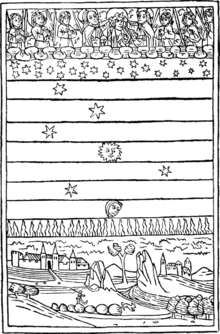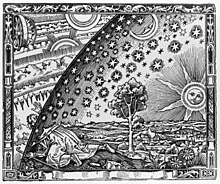Firmament: Difference between revisions
→External links: Seems like link from Denver church which are anti Vax. Removed Tags: Mobile edit Mobile web edit |
Expanding bare references using ReferenceExpander |
||
| Line 16: | Line 16: | ||
===The plurality of heaven=== |
===The plurality of heaven=== |
||
Perhaps beginning with [[Origen]], the different identifiers used for heavens in the Book of Genesis, ''caelum'' and ''firmamentum'', sparked some commentary on the significance of the order of creation (''caelum'' identified as the [[Empyrean|heaven of the first day]], and ''firmamentum'' as the heaven of the second day).<ref>Et vocavit Deus firmamentum caelum.</ref> Some of these theories identified ''caelum'' as the higher, immaterial and spiritual heaven, whereas firmamentum was of corporeal existence.<ref> |
Perhaps beginning with [[Origen]], the different identifiers used for heavens in the Book of Genesis, ''caelum'' and ''firmamentum'', sparked some commentary on the significance of the order of creation (''caelum'' identified as the [[Empyrean|heaven of the first day]], and ''firmamentum'' as the heaven of the second day).<ref>Et vocavit Deus firmamentum caelum.</ref> Some of these theories identified ''caelum'' as the higher, immaterial and spiritual heaven, whereas firmamentum was of corporeal existence.<ref>{{Cite book|last=Ross|first=Micah|url=https://books.google.co.uk/books?id=edVOGJKa7XUC&pg=PA237|title=From the Banks of the Euphrates: Studies in Honor of Alice Louise Slotsky|date=2008-01-01|publisher=Eisenbrauns|isbn=978-1-57506-144-3|language=en}}</ref> |
||
Christian theologians of note writing between the 5th and mid-12th century were generally in agreement that the waters, sometimes called the "crystalline orb", were located above the firmament and beneath the fiery heaven that was also called [[empyrean]] (from Greek ἔμπυρος). One medieval writer who rejected such notions was [[Pietro d'Abano]] who argued that theologians "assuming a crystalline, or aqueous sphere, and an empyrean, or firey sphere" were relying on revelation more than Scripture.<ref>{{cite book |last1=Grant |first1=Edward |title=Planets, Stars, and Orbs: The Medieval Cosmos, 1200-1687 |date=1994 |publisher=Cambridge University Press |page=321}}</ref> |
Christian theologians of note writing between the 5th and mid-12th century were generally in agreement that the waters, sometimes called the "crystalline orb", were located above the firmament and beneath the fiery heaven that was also called [[empyrean]] (from Greek ἔμπυρος). One medieval writer who rejected such notions was [[Pietro d'Abano]] who argued that theologians "assuming a crystalline, or aqueous sphere, and an empyrean, or firey sphere" were relying on revelation more than Scripture.<ref>{{cite book |last1=Grant |first1=Edward |title=Planets, Stars, and Orbs: The Medieval Cosmos, 1200-1687 |date=1994 |publisher=Cambridge University Press |page=321}}</ref> |
||
Revision as of 06:03, 6 March 2023


In biblical cosmology, the firmament is the vast solid dome created by God during the Genesis creation narrative to divide the primal sea into upper and lower portions so that the dry land could appear.[1][2] The concept was adopted into the subsequent Classical/Medieval model of heavenly spheres, but was dropped with advances in astronomy in the 16th and 17th centuries. Today it survives as a synonym for "sky" or "heaven".
Etymology
In English, the word "firmament" is recorded as early as 1250, in the Middle English Story of Genesis and Exodus. It later appeared in the King James Bible. The same word is found in French and German Bible translations, all from Latin firmamentum (a firm object), used in the Vulgate (4th century).[3] This in turn is a calque of the Greek στερέωμᾰ (steréōma), also meaning a solid or firm structure (Greek στερεός = rigid), which appears in the Septuagint, the Greek translation made by Jewish scholars around 200 BCE.
These words all translate the Biblical Hebrew word rāqīaʿ (רָקִ֫יעַ), used for example in Genesis 1.6, where it is contrasted with shamayim (שָׁמַיִם), translated as "heaven(s)" in Genesis 1.1. Rāqīaʿ derives from the root rqʿ (רָקַע), meaning "to beat or spread out thinly".[4][5] Gerhard von Rad explains:
Rāqīaʿ means that which is firmly hammered, stamped (a word of the same root in Phoenecian means "tin dish"!). The meaning of the verb rqʿ concerns the hammering of the vault of heaven into firmness (Isa. 42.5; Ps.136.6). The Vulgate translates rāqīaʿ with firmamentum, and that remains the best rendering.
— Gerhard von Rad [6]
Models of the Firmament
The plurality of heaven
Perhaps beginning with Origen, the different identifiers used for heavens in the Book of Genesis, caelum and firmamentum, sparked some commentary on the significance of the order of creation (caelum identified as the heaven of the first day, and firmamentum as the heaven of the second day).[7] Some of these theories identified caelum as the higher, immaterial and spiritual heaven, whereas firmamentum was of corporeal existence.[8]
Christian theologians of note writing between the 5th and mid-12th century were generally in agreement that the waters, sometimes called the "crystalline orb", were located above the firmament and beneath the fiery heaven that was also called empyrean (from Greek ἔμπυρος). One medieval writer who rejected such notions was Pietro d'Abano who argued that theologians "assuming a crystalline, or aqueous sphere, and an empyrean, or firey sphere" were relying on revelation more than Scripture.[9]
About this Ambrose wrote: "Wise men of the world say that water cannot be over the heavens"; the firmament is called such, according to Ambrose, because it held back the waters above it.[10]
This matter of the position of the "waters" above the firmament was considered by Augustine in De Genesi ad litteram (perhaps his least studied work): "only God knows how and why [the waters] are there, but we cannot deny the authority of Holy Scripture which is greater than our understanding".
Corporeality
Early Christian writers wrote at length about the material nature of the firmament, the problem arising from the barrier said to be created when it divided the waters above and below it.[11] At issue was the reconciliation of Scripture with Aristotle's cosmology.
Saint Basil rejected the notion that the firmament is made of solid ice, although Bede in Hexaemeron ignores the problem of the motion of celestial bodies (stars) in a solid firmament and declares that the siderum caelum (heaven of the celestial bodies) was made firm (firmatum) in the midst of the waters so should be interpreted as having the firmness of crystalline stone (cristallini Iapidis).[12]
History

The ancient Hebrews, like all the ancient peoples of the Near East, believed the sky was a solid dome with the Sun, Moon, planets and stars embedded in it.[13] Around the 4th to 3rd centuries BCE the Greeks, under the influence of Aristotle who argued that the heavens must be perfect and that a sphere was the perfect geometrical figure, exchanged this for a spherical Earth surrounded by solid spheres. This became the dominant model in the Classical and Medieval world-view, and even when Copernicus placed the Sun at the centre of the system he included an outer sphere that held the stars (and by having the earth rotate daily on its axis it allowed the firmament to be completely stationary). Tycho Brahe's studies of the nova of 1572 and the Comet of 1577 were the first major challenges to the idea that orbs existed as solid, incorruptible, material objects,[14] and in 1584 Giordano Bruno proposed a cosmology without a firmament: an infinite universe in which the stars are actually suns with their own planetary systems.[15] After Galileo began using a telescope to examine the sky it became harder to argue that the heavens were perfect, as Aristotelian philosophy required, and by 1630 the concept of solid orbs was no longer dominant.[14]
See also
- Abzu – Primeval sea in Mesopotamian mythology
- Cosmic ocean – Mythological motif
- Flood geology – Pseudoscientific attempt to reconcile geology with the Genesis flood narrative
- Heaven in Judaism – Dwelling place of God and other heavenly beings
- Nu – Ancient Egyptian personification of the primordial watery abyss
- Primum Mobile – Outermost moving sphere in the geocentric model of the universe
- Sky deity – Deity associated with the sky
- Wuji – The primordial in Chinese philosophy
Citations
- ^ Pennington 2007, p. 42.
- ^ Ringgren 1990, p. 92.
- ^ "Online Etymology Dictionary – Firmament". Archived from the original on 2012-10-18. Retrieved 2010-10-25.
- ^ Brown, Francis; Driver, S.R.; Briggs, Charles A. (1951). A Hebrew and English Lexicon of the Old Testament. Oxford University Press. p. 955.
- ^ "Lexicon Results Strong's H7549 – raqiya'". Blue Letter Bible. Blue Letter Bible. Archived from the original on 2011-11-03. Retrieved 2009-12-04.
- ^ von Rad 1961, p. 53.
- ^ Et vocavit Deus firmamentum caelum.
- ^ Ross, Micah (2008-01-01). From the Banks of the Euphrates: Studies in Honor of Alice Louise Slotsky. Eisenbrauns. ISBN 978-1-57506-144-3.
- ^ Grant, Edward (1994). Planets, Stars, and Orbs: The Medieval Cosmos, 1200-1687. Cambridge University Press. p. 321.
- ^ Boccaletti Dino, The Waters Above the Firmament, p.36 2020
- ^ Et dixit Deus, Fiat firmamentum in medio aquarum et sit dividens inter aquam et aquam
- ^ Randles, W. G. L. (1999). The Unmaking of the Medieval Christian Cosmos, 1500–1760. Routledge.
- ^ Seely, Paul H. (1991). "The Firmament and the Water Above" (PDF). Westminster Theological Journal. 53: 227–40. Archived (PDF) from the original on 2009-03-05. Retrieved 2010-02-02.
- ^ a b Grant 1996, p. 349.
- ^ Giordano Bruno, De l'infinito universo e mondi (On the Infinite Universe and Worlds), 1584.
Bibliography
- Grant, Edward (1996). Planets, Stars, and Orbs: The Medieval Cosmos, 1200-1687. Cambridge University Press.
- Andrews, Tamra (2000). Dictionary of Nature Myths: Legends of the Earth, Sea, and Sky. Oxford University Press. ISBN 9780195136777. Archived from the original on 2020-11-06. Retrieved 2021-02-01.
- Bandstra, Barry L. (1999). Reading the Old Testament: An Introduction to the Hebrew Bible. Wadsworth. ISBN 0495391050. Archived from the original on 2021-02-01. Retrieved 2021-02-01.
- Berlin, Adele (2011). "Cosmology and creation". In Berlin, Adele; Grossman, Maxine (eds.). The Oxford Dictionary of the Jewish Religion. Oxford University Press. ISBN 9780199730049. Archived from the original on 2021-02-01. Retrieved 2021-02-01.
- Blenkinsopp, Joseph (2011). Creation, Un-Creation, Re-Creation: A Discursive Commentary on Genesis 1–11. T&T Clarke International. ISBN 9780567574558. Archived from the original on 2021-02-01. Retrieved 2021-02-01.
- Broadie, Sarah (1999). "Rational Theology". In Long, A.A. (ed.). The Cambridge Companion to Early Greek Philosophy. Cambridge University Press. ISBN 9780521446679. Archived from the original on 2021-02-01. Retrieved 2021-02-01.
- Bunnin, Nicholas; Yu, Jiyuan (2008). The Blackwell Dictionary of Western Philosophy. Blackwells. ISBN 9780470997215. Archived from the original on 2020-10-14. Retrieved 2021-02-01.
- Clifford, Richard J (2017). "Creatio ex Nihilo in the Old Testament/Hebrew Bible". In Anderson, Gary A.; Bockmuehl, Markus (eds.). Creation ex nihilo: Origins, Development, Contemporary Challenges. University of Notre Dame. ISBN 9780268102562. Archived from the original on 2021-02-01. Retrieved 2021-02-01.
- Couprie, Dirk L. (2011). Heaven and Earth in Ancient Greek Cosmology: From Thales to Heraclides Ponticus. Springer Science & Business Media. ISBN 9781441981165. Archived from the original on 2020-11-02. Retrieved 2021-02-01.
- Grunbaum, Adolf (2013). "Science and the Improbability of God". In Meister, Chad V.; Copan, Paul (eds.). The Routledge Companion to Philosophy of Religion. Routledge. ISBN 9780415782944. Archived from the original on 2020-07-26. Retrieved 2021-02-01.
- James, E.O. (1969). Creation and Cosmology: A Historical and Comparative Inquiry. Brill. ISBN 9789004378070. Archived from the original on 2020-10-30. Retrieved 2021-02-01.
- López-Ruiz, Carolina (2010). When the Gods Were Born: Greek Cosmogonies and the Near East. Harvard University Press. ISBN 9780674049468. Archived from the original on 2021-02-01. Retrieved 2021-02-01.
- Mabie, F.J (2008). "Chaos and Death". In Longman, Tremper; Enns, Peter (eds.). Dictionary of the Old Testament. InterVarsity Press. ISBN 9780830817832. Archived from the original on 2021-02-01. Retrieved 2021-02-01.
- May, Gerhard (2004). Creatio ex nihilo. T&T Clarke International. ISBN 9780567456229. Archived from the original on 2021-02-01. Retrieved 2021-02-01.
- Nebe, Gottfried (2002). "Creation in Paul's Theology". In Hoffman, Yair; Reventlow, Henning Graf (eds.). Creation in Jewish and Christian Tradition. Sheffield Academic Press. ISBN 9781841271620. Archived from the original on 2021-02-01. Retrieved 2021-02-01.
- Muller, Richard A. (2017). Dictionary of Latin and Greek Theological Terms. Baker Academic. ISBN 9781493412082. Archived from the original on 2021-02-01. Retrieved 2021-02-01.
- Pennington, Jonathan T. (2007). Heaven and earth in the Gospel of Matthew. Brill. ISBN 978-9004162051. Archived from the original on 2021-02-01. Retrieved 2021-02-01.
- Pruss, Alexander (2007). "Ex Nihilo Nihil Fit". In Campbell, Joseph Keim; O'Rourke, Michael; Silverstein, Harry (eds.). Causation and Explanation. MIT Press. ISBN 9780262033633. Archived from the original on 2021-02-01. Retrieved 2021-02-01.
- von Rad, Gerhard (1961). Genesis: A Commentary. London: SCM Press.
- Ringgren, Helmer (1990). "Yam". In Botterweck, G. Johannes; Ringgren, Helmer (eds.). Theological Dictionary of the Old Testament. Eerdmans. ISBN 9780802823304. Archived from the original on 2021-02-01. Retrieved 2021-02-01.
- Rubio, Gonzalez (2013). "Time Before Time: Primeval Narratives in Early Mesopotamian Literature". In Feliu, L.; Llop, J. (eds.). Time and History in the Ancient Near East: Proceedings of the 56th Recontre Assyriologique Internationale at Barcelona, 26–30 July 2010. Eisenbrauns. Archived from the original on 1 February 2021. Retrieved 1 February 2021.
- Waltke, Bruce K. (2011). An Old Testament Theology. Zondervan. ISBN 9780310863328. Archived from the original on 2021-02-01. Retrieved 2021-02-01.
- Walton, John H. (2006). Ancient Near Eastern Thought and the Old Testament: Introducing the Conceptual World of the Hebrew Bible. Baker Academic. ISBN 0-8010-2750-0. Archived from the original on 2021-02-01. Retrieved 2021-02-01.
- Walton, John H. (2015). The Lost World of Adam and Eve: Genesis 2-3 and the Human Origins Debate. InterVarsity Press. ISBN 9780830897711. Archived from the original on 2021-02-01. Retrieved 2021-02-01.
- Wasilewska, Ewa (2000). Creation Stories of the Middle East. Jessica Kingsley Publishers. ISBN 9781853026812. Archived from the original on 2020-11-03. Retrieved 2021-02-01.
- Wolfson, Harry Austryn (1976). The Philosophy of the Kalam. Harvard University Press. ISBN 9780674665804. Archived from the original on 2016-05-07. Retrieved 2021-02-01.
- Wolters, Albert M. (1994). "Creatio ex nihilo in Philo". In Helleman, Wendy (ed.). Hellenization Revisited: Shaping a Christian Response Within the Greco-Roman World. University Press of America. ISBN 9780819195449. Archived from the original on 2021-02-01. Retrieved 2021-02-01.
External links

